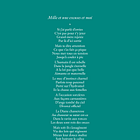“The collapse of biodiversity is a reality. On an international average, it is estimated that over the last 40 years, 60% of vertebrate populations (fish, birds, mammals, etc.) and 80% of insects have disappeared from the Earth.”
Snow in winter, mosquitoes in summer. Here around Paris, both have disappeared in two or three decades. Such a quick and radical environmental change is most likely unprecedented in the history of the world. We’re kindly asked to believe either that it’s not true, or not our fault.
Animals are so heavily impacted by the amount of pollution and destruction, and the disruption they cause in soils, water, food, atmosphere and climate.
Homo sapiens and his predecessors have owed their success so far to their ability to make the most of their environment, mainly by exploiting materials, plants, animals or other humans in a more or less authoritarian, rationalized, selfish or shared way.
The impact of this exploitation has increased throughout history along with technical and scientific progress, and its extent has remained without too many harmful consequences for those who practiced it, despite the losses due to sometimes extensive destruction and removals, even if of course it has happened that types of resources have been exhausted, such as deposits of raw materials or animal species, and the responsible populations have then had to turn to others, especially in cases where a strong dependence put them in danger of disappearance.
In the 19th century, the most numerous species that may have ever populated the earth, the endemic passenger pigeon of North America, was completely eradicated for commercial and leisure purposes.
But since the industrial revolution, these “progresses”, becoming massive and systemic, are beginning to be a real nuisance for humans.
With a critical threshold reached in the last decades, where the increase in life expectancy has stopped as the harmful effects on health have also increased to become now prevalent.
It is not very difficult to understand that if animal populations are decimated to such extent, it is because of the toxicity, not only chemical, of the new environment resulting from human action. And since we do not live on a different planet than them, we are as much exposed to it.
Human fertility rates, like those of other species, have fallen very seriously. Our reproductive cells are much less numerous and active than before.
Animals like fish see their morphology and behaviors shaken and disrupted because toxins perturb the functioning of cells and hormones.
These harmful disturbances are reminding of those experienced by human populations at the psychosociological level, where increasing problematic profiles, anxious, antisocial, aggressive and violent towards others and oneself, are reinforced, aggravated as they find themselves internalized and integrated, accepted and revendicated by individuals and their cultures.
So the behavioral and social model based on greed, dispossession, abuse, has become an existential threat to humanity after having been its first asset in the wild jungle, since it has now devised the means of its complete self-destruction, which can thus prove fatal rather quickly if these practices and these ends are not seriously regulated in fair concert on a global scale...






